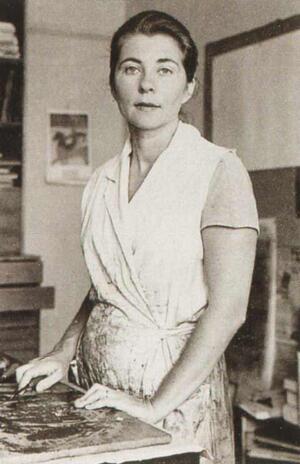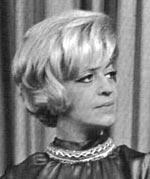Fayga Ostrower
Institution: Anat Falbel
Fayga Ostrower, born in Poland, began her artistic career after her family immigrated to Brazil, where she quickly developed a love and a talent for engraving. Despite some criticism, she chose to focus on abstract pieces after 1953. Her award-winning works have been displayed across the world, and she wrote many books reflecting on the power of art as a universal human language. Ostrower also taught art in Brazil, as well as at Spellman College in Atlanta.
Early Life
An engraver, designer and teacher, Fayga Perla Ostrower was born in Łódź, Poland, on September 14, 1920, the eldest daughter of Frimeta (1892–1940) and Ephraim (1895–1966) Krakowski. Her sister, Rachel (later Lewinsohn), was born in 1922, a brother, Eliezer, in 1924 and another brother, Dawid, in 1926. Poverty made her parents seek new opportunities and in 1921 they settled in the twin towns of Elberfeld and Barmen (Wuppertal) in Germany. Fayga attended primary school in Elberfeld and secondary school in Barmen, with the help of a scholarship. In 1933, after Ephraim was called on by the German police, he sought refuge in Belgium, his wife and children remaining behind. In 1934, when their situation became difficult, they too escaped to Belgium. They stayed for a year in Brussels, where Fayga resumed her studies. But the family soon had to leave again and the only option offered by the refugee organizations was Brazil. In March 1934 they traveled to Rio de Janeiro third class on the Josephine Charlotte, arriving the following month. Fayga, now thirteen years old, spent her time sketching the passengers and even the captain. The family went to live in an outlying district, Nilópolis, where there was a Jewish community and where Efraim Krakowski, a proud Zionist and Conservative Jew, was sometimes invited to officiate at SabbathShabbat services at the synagogue. Since life was extremely difficult, the children had to work to help their parents. Fayga took a secretarial course and worked in a large company, but decided to enroll in a free art course at the Fine Arts Association and never looked back.
Early Art Career
One of her first works was creating wood engravings to illustrate O Cortiço (The Slum) by Aluísio de Azevedo and Ignazio Silone’s Fontamara. In 1946 she began her design studies at the Brazilian Society of Fine and Graphic Arts in the Getúlio Vargas Foundation, where she took wood engraving classes with Axel Leskoschek, metal engraving with Carlos Oswald and Tomás Santa Rosa, and art history with Anna Levy. In this initial phase, until 1953, her work shows the impact of expressionism and an interest in social themes, influenced by the work of Käthe Kollwitz. She was awarded prizes in exhibitions in 1948 and 1950. She then abandoned the depiction of figures and began to work with abstract designs, arousing criticism that stemmed from the ideological prejudices of the period. However, Fayga resisted, continuing her search for her own internal rhythm and her ethical questioning, while also asserting—as she would do for the rest of her life—her respect for art as the eternal language of humanity. In 1955 she was awarded a Fulbright Scholarship and studied with the engraver Stanley Hayter in New York. She exhibited in the São Paulo Biennial Exhibitions between 1951 and 1967, winning various prizes. She also took part in the twenty-ninth and thirty-first Venice Biennials (1958 and 1962), winning the international engraving prize in 1958, and was included in the special category of artists awarded international prizes in these exhibitions.
Exhibits and Writing
Her work has been shown in the most important engraving exhibitions (Second Mexican Biennial, 1960; First Certame Latin American Engraving Exhibition, Buenos Aires, 1960; Modern Art in Brazil, Buenos Aires, Rosário, Santiago, and Lima, 1957; Contemporary Brazilian Art, London, Vienna, and Bonn, 1965; Contemporary Brazilian Engravers, Cornell University. She has had solo exhibitions at the Pan-American Union, Washington, 1955; the San Francisco Fine Arts Museum, 1957; the Stedelijk Museum, Amsterdam, 1959; and the Chicago Fine Arts Institute, 1960. Her works are to be found in many museums throughout the world, among them the Modern Art Museums in Rio de Janeiro and New York, the Fine Arts Museum in Philadelphia, the Contemporary Art Museum in São Paulo, the Library of Congress in Washington, the Institute of Contemporary Art in London, the Victoria and Albert Museum in London, and the Albertina Museum in Vienna.
Ostrower taught art in schools in Brazil, beginning in 1954 at the Museum of Modern Art. She also taught at Spellman College, Atlanta, in 1964. She wrote about the mysteries of life and art in clear but intense language in her Universos da Arte (Universes of Art), now in its 22nd edition; Criatividade e Processos de Criação (Creativity and Processes of Creation); Acasos e Criação Artística (Chances and Artistic Creation); A Sensibilidade do Intelecto: Visões Paralelas de Espaço e Tempo na Arte e na Ciência (The Sensitivity of the Intellect: Parallel Visions of Space and Time in Art and Science), which received the Jabuti Book Prize in Brazil; and Goya: Artista Revolucionário e Humanista (Goya: Revolutionary Artist and Humanist). Between 1963 and 1966 she was the Vice-President of the Brazilian Commission of the International Association of Plastic Arts of UNESCO, participating in its fourth International Congress in New York in 1963.
Heinz Ostrower
Fayga’s husband, Heinz Ostrower (1913–1992), was born in Jauer (Jawor), Silesia, now part of Poland. He joined the KPO, the opposition Communist Party, and fought against both the rising Nazism and the sectarian policies imposed by Stalin on the German Communist Party. He was still a medical student when arrested by the Gestapo during a demonstration in 1935 and imprisoned. In 1937 he was deported to Brazil. In Rio de Janeiro he found work at a bookstore that lent books to subscribers and it was here, in 1939 or 1940, that he met Fayga. They married on May 10, 1941. Later Heinz resumed his political activity, giving courses on Marxism and the problems of contemporary history. He became naturalized in 1951 (as was Fayga). In the 1980s he concentrated his energy on the Center for Studies and Community Action (CEAC), an organization based in Nova Iguaçu, which addressed the social movements of the poorer people of the Baixada Fluminense and Jacarepaguá areas of Rio de Janeiro. He directed this center from 1983 to 1989. The couple had a son, Carl Robert (b. 1949), and a daughter, Anna Leonor (b. 1952). Fayga Ostrower died on September 12, 2001.
Further Reading
Ostrower, Fayga. Acasos e Criação Artistica. Rio de Janeiro: Editora Campus, 1990.
Ostrower, Fayga. Criatividade e Processos de Criação. Rio de Janeiro: Imago, 1977.
Ostrower, Fayga. Goya: Artista Revolucionário e Humanista. São Paulo: Imaginário, 2001.
Ostrower, Fayga. A Sensibilidade do Intelecto: Visões Paralelas de Espaço e Tempo na Arte e na Ciência. Rio de Janeiro: Editora Campus, 1998.
Ostrower, Fayga. Universos da Arte. Rio de Janeiro: Editora Campus, 1983.




